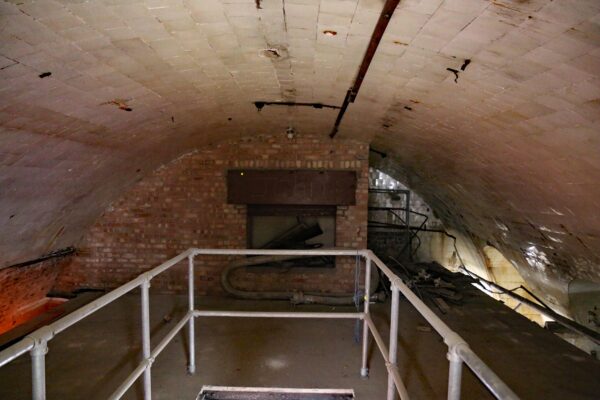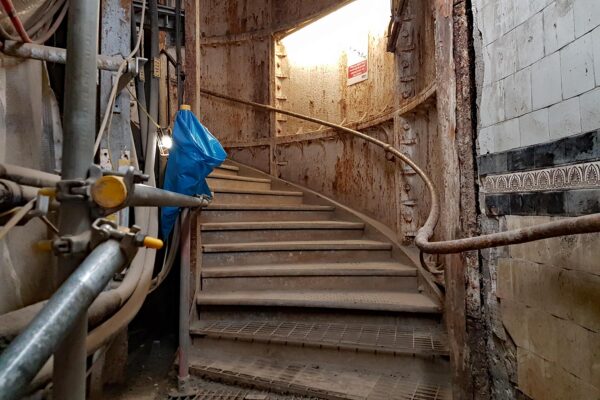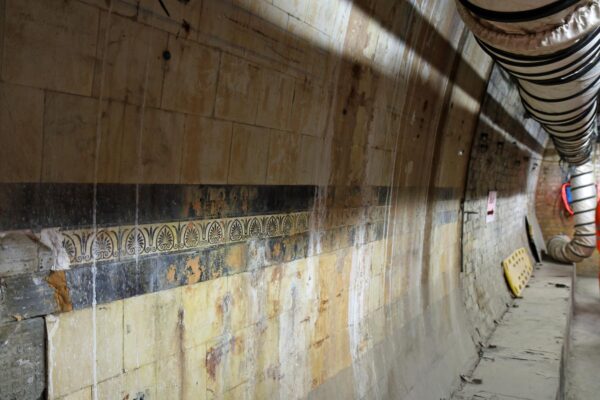Deep under the City of London lies the oldest disused tube station in London, and one that’s currently a hive of activity.
This is King William Street station, and it’s currently serving a useful function as part of the Bank station upgrade project, which I wrote about last week.
King William Street opened in December 1890 as the northern terminus of the world’s first deep tube tunnel — the City and South London Railway (C&SLR), which ran from Stockwell to the City. Built as a single brick-vaulted space under the streets, it had space for one train in the centre, with platforms on either side. This was later swapped to a single platform in the middle and trains on either side to increase capacity.
During planning, it was expected that the railway would pull the carriages along on cables, as was used in mines, but they switched to the newly developed electric locomotive to pull the carriages along.
Unfortunately, the approach to King William Street station was up a steep slope, and sometimes the locomotives got stuck and needed to be pushed up by the following train. The lack of capacity at King William Street, and the desire to extend the railway further north saw, what is today called the Northern line, dig new tunnels under the Thames and bypass the old station entirely as it headed over towards Bank station.
King William Street tube station closed on 24 February 1900, less than 10 years after it opened.
It was used as a WW2 shelter, and later for document storage, but has otherwise remained a lost echo of the early transport history, until now.
It’s proving to be a very useful support site for the construction of the new tunnels for the Bank station upgrade project, and as the main access route for people working on the site.
Although the lift shaft that passengers would have used is long since gone, the spiral staircase remains, and that’s how people get down to the disused tube station.
Entry is through two CCTV monitored locked doors, down several flights of stairs, and then a secured turnstile, and now you’re into a hidden world of old tiles, decades of dust and lots of modern intrusions.
Heading further down, the spiral staircase will look familiar to anyone who has been on a Hidden London tour, or had to use the stairs at some of the older tube stations.
Much of the cabling that runs around the old station is modern, being part of the Jubilee line Extension project, which made use of the old C&SLR tunnels under the Thames to run power cables into the City. Those old tunnels are now pretty much severed by the Jubilee line though.
The main block used by construction staff had a mezzanine floor added during WW2, and under the dirt, you can still see the odd remnant from the time they were used as shelters from bombs.
A number of old photos and drawings from the time when the station thronged with passengers rather than construction workers line the walls now, and further along, the deep shaft being constructed for the new Bank station upgrade has punched a hole through the running tunnel of the old railway.
However, the old platform space is still intact, being used today as storage a man-caves delight of nuts and bolts for the building site.
Further down, the tunnel is sealed off, as the rest is to be protected heritage, and just beyond the grills we can see the old toilet blocks from the war and the railway tunnel leading under the Thames.
At the moment the rest of the site is also sealed off, as not needed for the construction works, but a short visit gave a glimpse into this oldest of disused tube stations.
When the Bank tube station upgrade is completed, a small side tunnel will link the new Northern line to the old station so that it can be used for access by engineering works.
Older photos and more background here, here, and here.
Some more photos:




















Thanks Ian for a fascinating post.
Rob Bell in his Tube series last year paid a visit down there, as part of his programme on the Norther Line.
It would be great if the LT Museum could include this in on of its Hidden London tours. It would be an instant success.
Fascinating stuff. Loving the history of what was King William Street station before it was closed down and was replaced by Bank & Monument stations as we know of today and people using the 2 stations. As it’s a Underground interchangeable station were Central, Northern, Waterloo & City, Circle, District and Docklands Light Railway meet.
Plus it’s not too far from London Cannon Street and Fenchurch Street stations. As Tower Hill tube station is close to and Tower Gateway DLR station is next door to Fenchurch Street. And Cannon Street tube station is next door to where you can interchange from London Underground to Southeastern at Cannon Street. But what a wonderful piece of history in London.
Just love stories on the London underground. This is so interesting, as always. JD
These early examples of the under ground railways in London should not only be preserved but restored after all the U.K. invented it, so its part of our heritage.
Fantastic thank you for writing and sharing this
After the Embankment loop and the Harrod’s tunnel from its ‘depositories’ near Barnes (if it exists,) this is the site I’m eager to explore. Lucky you.
A myriad of tunnels and passages lie hidden under London. Interesting to see photos.
Shame that more hasn’t been done with the old GPO railway tunnels, apart from the bit now open as a tourist attraction.
Thank you. Fascinating.
Bloody hell, just these photos make my insides turn! Thank goodness you don’t have claustrophobia, Ian!